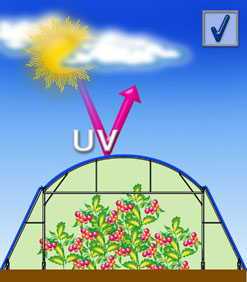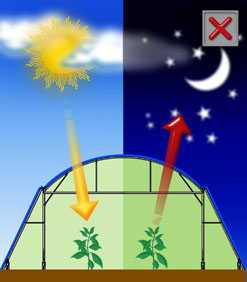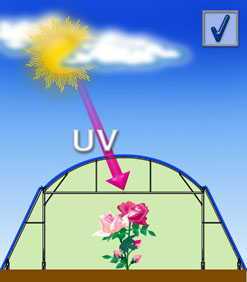Types of films for covering greenhouses and tunnels: |
|
| Film code | Description of the properties of the film. |
| 1513 | YELLOW / WHITE
3-layer stabilized film, recommended for greenhouse sides. The yellow side should be installed on the inside of the greenhouse, attracting certain insects, such as the whitefly, and reducing their dispersal on plants. The yellow color helps protect plants from pests. |
| 1703 | UVA SCATTERING
3-layer stabilized UV film, recommended for protecting crops from rain, wind, hail, etc. It can be supplied with light-scattering properties and/or with an anti-condensation coating that does not allow moisture to condense on the inner surface of the film (*). |
| 1504 | UVA DISPERSING ROSE GROWING
3-layer stabilized anti-viral film, resistant to sulfur compounds, with a special additive that blocks UV (ultraviolet radiation) to reduce the darkening of red rose petals, as well as to reduce the activity of fungi, insects, and viruses in the greenhouse. Can be supplied with light scattering properties and/or with an anti-condensation coating that prevents moisture from condensing on the inner surface of the film (*). |
| 1501 | Diffuse IR (Infrared)
3-layer stabilized durable film with anti-condensation coating. Protects against the dissipation of heat accumulated during the day into the atmosphere. During the night, thus keeping warm, protects against low night temperatures and frost and ensures an earlier harvest and higher product quality. Comes with an anti-condensation coating that does not allow moisture to condense on the inner surface of the film, thus improving light transmission and reducing the risk of being affected by certain diseases. The light correction and/or diffusion level can be adjusted according to the requirements of a particular region or growth of certain crops. |
| 1502 | SCATTERING IR FOR ROSE GROWING
3-layer stabilized long-lasting film with anti-condensation coating. COMBINES THE PROPERTIES OF TWO PREVIOUS TYPES OF FILM. |
| 1507 | DOUBLE ACTION IR SCATTERING
3-layer stabilized durable film with anti-condensation coating. Combines the effect of keeping you warm during the night with the cooling effect on hot days. By reflecting / absorbing thermal infrared radiation, such a film reduces the temperature in the greenhouse during the daytime relative to a conventional film, thus preventing overheating of the plants and creating better conditions for working in the greenhouse. Especially recommended for countries with hot climates. |
| 1508 | DOUBLE ACTION IR DISPERSING FOR GROWING ROSES
Same properties as the previous type plus UV filtering. |
| 1904 | DOUBLE COLOR DOUBLE LAYER FILMS
Various combinations of two colors of the film on different sides: from white or light orange to black on one side and white or black on the other. Films are used for various purposes, including mulching crops. * Available sizes: Film thickness from 30 to 200 microns, according to the order. |
| 1510 | UV STABILIZED FILMS FOR GREENHOUSE SIDEWALLS
UV stabilized films, designed for long-term operation, with a thickness of 120 microns. * Dimensions - on request. |
| 1509 | DIFFUSING FILM FOR SIDE WALLS OF GREENHOUSES IR
UV stabilized films, designed for long-term use, with a thickness of 120-200 microns. Retains heat by reducing sidewall losses and reducing heating costs. The recommended thickness is 120-200 microns. Available in various widths/lengths, according to the customer's request. |
| 1512 | CONVECTION TUBES
Foil hoses for supplying warm (for heating) or cold (for cooling) air inside the greenhouse. Available in various diameters and lengths. Perforations - according to the customer's order. (distance and diameter of perforation)
Photo at the bottom right.
|
| | * Film width up to 5 meters. |
|
| |
Properties of films in pictures
Additional properties that can be imparted to film coatings will be better understood by looking at these illustrations.
The pictures on the left show how a regular plastic wrap works.
The pictures on the right show how modified films work. |  | | | The light scattering film provides more uniform illumination, which creates the best conditions for plants and protects leaves and fruits from burns. |  |  | | The film with anti-condensation properties prevents the formation of condensation (large drops) on its inner surface, which promotes the penetration of more light into the greenhouse and protects the plants from wetting the leaves with water drops, which, in turn, protects the plants from the development of various diseases. |  |  | | Filtration of ultraviolet radiation has an excellent effect in protecting plants from pests and diseases. Many diseases are carried by small insect pests such as the whitefly. In order for insects to identify host plants, they need light that contains an ultraviolet component. This is due to the properties of their visual perception. The absence of an ultraviolet component in the spectrum does not allow pests to visually find plants. As a result, the damage to plants by pests and diseases is significantly reduced, which makes it possible to dramatically reduce the use of pesticides or completely abandon it. |  |  | | Heat loss in greenhouses from infrared radiation at night can be significant. Special films reflect infrared radiation inward and allow you to keep warm inside the greenhouse on cold nights. |  |  | | When growing roses, farmers are faced with the problem of ultraviolet radiation exposure to the anthocyanin pigment, which is found in pink and red rose petals. Under the influence of ultraviolet light, the petals darken. To avoid this, films are produced with a special color correction that filters ultraviolet light. However, there are varieties of roses that, on the contrary, require dosed ultraviolet radiation. These are varieties that do not have an even color of babbling, but two-tone or half-tone colors. For such varieties, a special film of the "Nectarine" line has been developed, which allows obtaining the desired color of rose petals. |
|
|